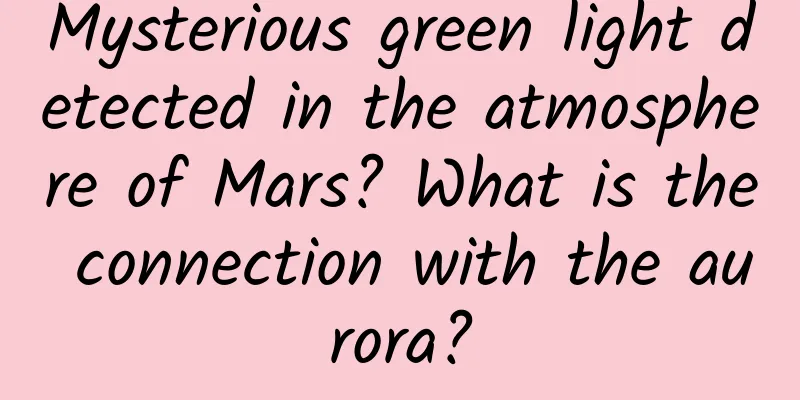Mysterious green light detected in the atmosphere of Mars? What is the connection with the aurora?

|
Astronomers detect a fascinating green glow in Mars' atmosphere Artist's impression of the Martian airglow. (ESA) Astronomers have detected a fascinating green glow in the Martian atmosphere, and it is produced by a process very similar to the air glow on Earth. When solar radiation hits the Martian atmosphere, it breaks carbon dioxide into carbon monoxide and oxygen. It is the oxygen atoms that are responsible for the green glow. Earth's airglow Previously, this glow had only been detected in the sky above Earth. Its discovery in the Martian atmosphere will help us better understand the processes that cause air glow on Earth and elsewhere. "The brightest light seen on Earth is the night glow. More specifically, a particular wavelength of light emanating from oxygen atoms that has never been found on any other planet," said Jean-Claude Gerard, an astronomer at the University of Liège in Belgium and lead author of a new paper describing the phenomenon. The Earth's sky is never completely dark, not even in the middle of the night, even after light pollution, starlight and diffuse sunlight have been extracted. Molecules in the atmosphere are constantly undergoing different processes that cause them to glow faintly across a range of wavelengths. Earth's Aurora This light is not entirely different from the aurora, as they are both produced by the same particles - except it is dimmer and the mechanism behind it is different. The aurora is emitted by charged particles produced by the solar wind, which ionizes atmospheric atoms, causing them to form flashes of light in the sky. Airglow, on the other hand, is caused by the interaction between sunlight and the atmosphere and can be roughly divided into two categories. Nightglow: When atoms are broken down by solar radiation during the day, excess energy is released in the form of photons. Nightglow has been observed on Venus and Mars, as well as on Earth. Venus's airglow What astronomers are observing now in the Martian atmosphere is dayside airglow — a phenomenon that is much harder to detect because its faint presence far outweighs daylight. On Earth, it only appears when molecules in the atmosphere absorb sunlight, which gives them more energy, causing them to emit it as radiation at the same or slightly lower frequency than what was originally absorbed. In images taken by the International Space Station (ISS), airglow is more obvious when the camera is looking through the top of the atmosphere rather than directly down. Scientists have suspected that airglow on Mars appeared in 1979. But Mars orbiters facing directly at the Martian surface have not detected it until now. Earth's night glow. (NASA) So, learning from the ISS, the team reoriented the nadir and occultation instruments on the Mars Discovery Orbiter (Nomad) from a position directly facing Mars to one looking through the atmosphere at the Martian horizon. From this position, they made a series of observations of the Martian atmosphere at altitudes ranging from 20 to 400 kilometers (12 to 250 miles). Mars Discovery Rover (Nomad) When they analyzed the data, they found green rays in both optical and ultraviolet wavelengths in all of the daytime observations. "The radiation is strongest at about 80 kilometres and varies depending on the distance between Mars and the sun," explained planetary aeronautician Ann-Karin Vandal of the Royal Institute for Space and Aeronautics of Belgium. When the team simulated the process behind the emission, they found that it was produced by a process very similar to airglow on Earth. When solar radiation hits the Martian atmosphere, it breaks carbon dioxide into carbon monoxide and oxygen. It's the oxygen atoms that are responsible for the green glow. Interestingly, the visible wavelength of this light is 16.5 times longer than the ultraviolet wavelength. "The observations at Mars agree with previous theoretical models, but are inconsistent with the actual glow we find around Earth, where the visible emission is much weaker," Gerard said. "This suggests that we need more time to understand how oxygen atoms react, which is very important for our understanding of atomic and quantum physics." The team suggests that the discrepancy could be a problem with the way Earth-observing instruments are calibrated. Obviously, the best approach is to do more science. The research has been published in the journal Nature Astronomy. by: Josh K. Elliott FY: Skylee If there is any infringement of related content, please contact the author within 30 days to delete it. Please obtain authorization for reprinting, and pay attention to maintaining integrity and indicating the source |
<<: Understand "International Customs Day" in 80 seconds!
>>: Scallions can remove the mutton smell and are effective whether eaten by sheep or humans!
Recommend
The role of iodine
Because we do not pay attention to some details i...
The efficacy and function of wild impatiens
Impatiens balsamina is a relatively familiar trad...
Don't buy food with these words on the package! How many do you have at home?
This article was reviewed by Pa Li Ze, chief phys...
The efficacy and function of rock pepper grass
I wonder if you have ever heard of rock peperomia...
The efficacy and function of eggplant leaves
Many people are not very clear about eggplant lea...
The efficacy and function of clam meat
Clam meat is a familiar medicinal material with u...
The efficacy and function of natural agarwood
The efficacy and role of natural agarwood, beeswa...
How to eat pine pollen
Everyone knows that pine pollen is a very good po...
Why are there always so many small animals around capybaras?
If life is a game, then friends are the most spec...
The efficacy and function of peony vine
Do you know what peony vine is? If you know, do y...
Huanglian Shangqing Pills
Huanglian Shangqing Pills is a kind of traditiona...
Effects of Zhibai Dihuang Wan
There are many common medicines, so when choosing...
The "blue chicken" unique to our country is mysterious and charming!
Recently, when sorting out infrared camera data i...
If you wake up like this every day, your body will be ruined!
Planning and production Source: Higher-end humans...
The turtles that appeared in groups on the river bank are not actually that many...
Not long ago, a piece of news like this became a ...









